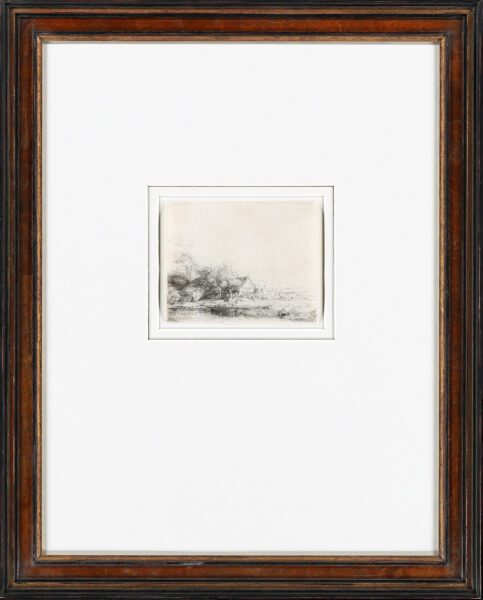“Landscape with a Cow drinking”, c. 1650
Etching and drypoint: 10,6 x 13,3 cm;
With narrow margins
"*" indicates required fields
Notes
During his lifetime, Rembrandt’s extraordinary skills as a printmaker were the main source of his international fame. Unlike his oil paintings, prints travelled light and were relatively cheap. For this reason, they soon became very popular with collectors not only within, but also beyond the borders of the Netherlands.
This scene with a little farmhouse sheltered by some trees, a canal with a small, moored boat and a cow drinking at the water’s edge would be a quintessentially Dutch landscape, were it not for the rocky escarpment behind the building and the hills in the distance. Rembrandt took familiar motifs, such as a langhuis and the canal, and placed them in a more picturesque landscape. He may have seen and sketched the building and the canal near Diemen, where this type of building is common (see: Schneider, 1990, p. 155; and Hinterding, 2008, p. 448), while the mountainous scenery was probably inspired by Bruegel or Goltzius, who unlike Rembrandt had traveled south, or by the dramatic landscapes of Hercules Seghers. Although he was personally unfamiliar with such places, Rembrandt in this small etching achieved a surprising harmony and continuity between the Dutch foreground and the more exotic background.
The Landscape with the Cow exists in two life-time states, with only a tiny change between the two: in the second state, Rembrandt added a few lines of shading to the meadow just to the right of the cow. Of the first state, only ten impressions are known in public collections.
Literature
Bartsch 237; Hind 240;
The New Hollstein, 2013, no. 251: second state (of V)
Plate in existence, private collection USA
with Nowell-Usticke (1967): C2+
Provenance
- Probably with William Smith, London.
- British Museum, London (Lugt 300; with the acquisition no. [18]43 /2-7 /145, probably relating to Smith);
- acquired from the above; with their duplicate stamp (Lugt 305) and initials of Campbell Dodgson (Keeper of Prints & Drawings, 1912–32).
- With E. & R. Kistner, Nuremberg.
- Private Collection, Switzerland; acquired from the above in 1991 (DM 28,000);
- then by descent.
- Christie’s London
- Private Collection, The Netherlands





